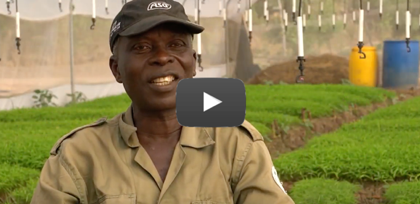This is the third blog in a series leading up to the 2020 WEF Annual Meeting, which is focused on “Stakeholders for a Cohesive and Sustainable World”
The projected quadrupling of global GDP by 2060 presents both tremendous risks and opportunities for the sustainable management of natural capital. By 2060, global average per capita income is projected to reach the current OECD level (around US$40,000), bringing with it higher material use from increases in consumption and production—unless there is a transformation to greener economies. Conversely, embracing a circular economy model presents great potential for economic growth, with an estimated US$4.5 trillion business opportunity. However, the degradation of natural capital threatens the ecosystem services on which more than 40 percent of total world employment, or 1.2 billion jobs, depend directly, along with billions more jobs with indirect linkages to natural capital.
There are numerous examples of public and private actors beginning to tap into these market opportunities. Below, we feature some of our latest resources and case studies that illustrate the role green industry can play in strengthening the sustainable management of natural capital. However, while much is being done across a variety of different sectors of the global economy, much more is needed to transform industry to become more sustainable and transition from a linear take-make-waste to a circular economy model.
Creating more sustainable product alternatives
Companies of all sizes are increasingly profiting by offering consumers more sustainable products and services. However, the green economy still only represents 6 percent of the market capitalisation of listed global companies, amounting to approximately US$4 trillion. Wood markets in Africa, for instance, are expected to exceed US$100 billion by 2030, but 93 percent of its current wood supply comes from natural forests. Several companies have emerged to respond to increasing demand for more sustainable sources of wood, including:
- EcoPlanet Bamboo produces sustainable bamboo as an alternative timber and fiber for industrial markets. It has invested in research to identify new species and in the development of manufacturing technologies. EcoPlanet Bamboo operates in Africa and Central America, including under a PPP model in Ghana and Rwanda, and is expanding into Southeast Asia.
Likewise, with an estimated growth in demand of 20 million homes each year, global materials use is projected to more than double by 2060. Therefore, new materials and methods are required, with recycling projected to become more competitive than primary extraction. Several companies are tapping into this market by selling green building materials, such as green concrete made from fly ash, recycled construction waste, and interlocking blocks.
- In India, Development Alternatives is making bricks using fly ash, in a project supported by the Green Economy Coalition. This creates a win-win for power plant operators by reducing ash waste disposal costs and for local communities by causing less environmental damage.
Adopting sustainability standards and certifications
Certifications and standards are important means of implementation for the green economy—they provide a mechanism to internalize the environmental costs of production, incentivize producers to improve their environmental track records, and give consumers more sustainable options. Examples of their use are increasing, with the global organic food and beverage market expected to grow 16 percent per year to reach US$327 billion by 2022. Recent research includes a report on the growth of standards, a guide on the costs and benefits of certification, and a handbook on building sustainable supply chains. They also feature case studies, including:
- In Cambodia, where expansion of rice fields is decreasing the size of forests and the ecosystem services they provide, IBIS Rice is providing farmers with performance-based payments for cultivating sustainable, wildlife-friendly rice. Where producers demonstrate that their rice was grown sustainably, it is purchased for a premium price. Certified as organic in Europe and the US, IBIS rice and other snacks sell worldwide.
Recent resources also highlight that many corporations define their own standards. Examples include Starbucks’ CAFE practices, Olam's Livelihood Charter, and Mondelez International’s Cocoa Life program. In particular, one report looks into how pollinator-friendly practices can be better integrated into certifications. For example:
- The Body Shop, which sources more than 2,000 ingredients that come mainly from plants, has adopted an Enrich not Exploit Commitment across its supply chains and, as part of this, considers it crucial to secure pollination services. The company has a Community Trade Sourcing Programme that builds the capacities of its suppliers and a Sustainable Sourcing Charter that commits to sustainable agricultural practices. Some of its supply chains do not use pesticides and others are certified organic.
Developing and scaling up circular economy business models
By moving towards the circular economy, business can capture significant benefits, including increased growth, competitive advantage, cost reduction, and supply chain and resource security. Embracing a circular economy is also projected to create around 6 million new jobs, along with an additional 18 million jobs if there is a transition to greater energy efficiency and use of renewables. However, despite a growing interest in circularity, efforts to reduce, reuse, and recycle remain insufficient—just 9 percent of plastic produced globally has been recycled. Each year, this plastic pollution results in a loss of US$500 billion to US$2.5 trillion in the value of benefits derived from marine ecosystem services.
Transforming economies and industries to become more circular will require collaboration—governments can set targets and establish regulations and policies with financial incentives such as taxes, whereas businesses can drive innovation in product design and services. Together, the public and private sectors can also bring greater financial and human resources to accelerate research and development. For instance:
- In 2018, Unilever opened a sachet recycling pilot plant in Indonesia. In partnership with the Fraunhofer Institute, Unilever has been co-developing a sachet manufacturing process using high quality plastics that enables closed-loop recycling since 2011.
- In India, Banyan has developed a proprietary plastic cleaning technology that removes inks and other contaminants using environmentally friendly detergents and solvents to supply near-virgin quality recycled granules. The company has also developed a data platform to integrate “last-mile” collectors into its supply chain.
Plastic is not the only material that needs an improved recycling system. As the circular economy increases our use of renewables, it is also producing waste. PV solar modules, which have a lifespan of about 30 years, eventually degrade, but the capacity for recycling their valuable materials remains limited. There is increasing momentum to change this, but more is needed to deal with PV waste globally—estimated to grow to 60-78 million tons by 2050. Collaboration between the public and private sectors is critical to improve process efficiency, recycling rates, and environmental performance in the waste sector. An example:
- In 2018, Veolia, the French water and waste group, opened a solar recycling plant. It has a contract with PV Cycle France to recycle 4,000 tonnes of solar panels by 2022.
TAKE ACTION
- ENGAGE with the GGKP Epert Working Group on Natural Capital
- ENGAGE: Enroll in ILO’s 2020 course on green jobs and attend the Green Jobs Forum
- DISCOVER What’s New: Stay up to date on the latest knowledge via Twitter, LinkedIn, Facebook, and GGKP's Knowledge Update Newsletter
ADDITIONAL READING
The opinions expressed herein are solely those of the authors and do not necessarily reflect the official views of the GGKP or its Partners.




